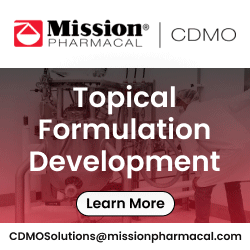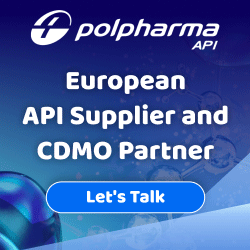Active Filter(s):
Overview of topical formulation development services for semi-solid dosage forms & topical products like creams, lotions, pastes, ointments, etc.
Q1. What is topical drug delivery and what are the advantages?
Topical delivery is defined as the application of a pharmaceutical dosage form to the skin for direct treatment of a cutaneous disorder or the cutaneous manifestation of a general disease. This is done with the intent of confining the pharmacological or other effects of the drug to the surface of the skin.
As our understanding of the anatomy and physiology of the skin has improved, it has facilitated the development of technologies and topical products that effectively and quantitatively deliver solutes across the skin barrier to specific target sites.
Topical delivery systems are self-contained, discrete pharmaceutical dosage forms that are designed to deliver drugs via intact skin or body surface routes of administration (transdermal route for transdermal products, ocular, and intrauterine). Topical pharmaceutical delivery systems achieve this by introducing a drug to the surface of the body, in a formulation which can be absorbed.
These topical formulations or topical products contain one or more active pharmaceutical ingredients (APIs) dissolved or uniformly dispersed in a suitable base with suitable excipients such as emulsifiers, viscosity-increasing agents, antimicrobial agents, antioxidants, or stabilizing agents.
Skin patches are an example of topical delivery systems. Other systems involve sprays applied to the mucus membranes of the nose, pharmaceutical gels, inhalation aerosols, eye drops, or topical cream formulations which may be rubbed into the skin.
Recently, such pharmaceutical delivery systems are becoming progressively popular due to their convenience and affordability. Patients tend to prefer methods which are painless and easy, which is why many pharmaceuticals come in the form of topical drug products which can be applied directly to the skin.
Topical drug delivery has a number of other advantages, which make them attractive to formulators and consumers, some of which are listed below:
- Alternative to oral medications.
- Fewer risks of gastrointestinal difficulties.
- Fewer risks of drug abuse.
- Easy administration.
- Reduced hospital congestion.
- The ability to deliver drug substance more selectively to a specific site.
- Avoiding fluctuations in drug levels (inter- and intra-patient variations).
- Improved compliance and enhanced suitability for self-medication.
- Ideal site for the pharmaceutical delivery of drug substances for both local and systemic effects.
Q2. What are the different types of liquid and semisolid topical drug products?
There are several topical drug products (dermatologic products) available to treat surface wounds which apply directly to damaged tissue. Such formulations facilitate local action, act on the surface of the skin, exert their actions on the stratum corneum, or modulate the function of the epidermis and/or the dermis.
The medium used in formulating a topical, semi-solid pharmaceutical drug product or topical liquid drug product determines the product's consistency (dense and greasy or thin or watery) and whether the active ingredient stays on the surface or penetrates into the body. Vehicle choice depends on where to use the drug, aesthetic value, and ease of use.
Topical Semi-Solids
Semisolids are topical dosage forms intended for external dermatological applications which facilitate local or systemic effects. Semi solids usually have intermediate viscosities and rigidities between that of a solid and a liquid. Semi-solids dosage forms are available as ointments, creams, gels, pastes, foams, suppositories, etc. Some of these semi-solid topical products are explored in detail below.
- Cream
Creams are emulsions of water and oil classified as oil in water (o/w) or water in oil (w/o) emulsions. O/W creams spread easily and do not leave the skin greasy and sticky, whereas W/O creams are greasy and more emollient. Medical topical cream formulations also contain suitable excipients such as emulsifiers and preservatives.
- Gel
Topical gel formulations are of increasing interest in the dermatology industry (dermatologic products). Gel formulations are typically transparent or translucent, water-based semi solid dosage forms with good spreading properties and pleasing aesthetic characteristics.
- Ointment
Ointments are semisolid preparations intended for external application to the skin or mucous membranes. Ointments can be classified into four types depending on the carrier of the drug or base used for its formulation:
(1) Ointments with hydrocarbon or oleaginous bases
(2) Ointments with an absorbent or anhydrous base
(3) Ointments with an emulsion or water miscible base
(4) Ointments with water soluble bases.
- Paste
Pastes are mixtures of powder and ointments which are often defined as concentrated suspensions of oil, water and powder. The addition of powder increases the porosity of the topical formulation and also improves its consistency, which in turn increases the topical products’ capability to adhere to the skin. Pastes can also be classified into the four categories listed above, for ointments.
Topical Liquids
Topical liquids are liquid dosage forms administered topically via the dermal route of drug administration. Topical liquid dosage forms include the likes of lotions, liniments, collodions, paints, suspensions, solutions, etc. Some of these liquid topical products are explored in detail below.
- Lotion
Lotions are usually considered thicker than topical solutions and more likely to contain oil as well as water or alcohol. A lotion separates into parts with time so it needs to be shaken into a suspension before use. Lotions are easy to apply to large areas and are also suitable for application to hairy areas.
- Liniment
Liniments are fluid, semi-fluid or, occasionally, semi-solid dosage forms intended for application to the skin. They may be alcoholic or oily solutions or emulsions. Most are massaged into the skin (e.g. counter-irritants).
- Collodion
Collodions are syrupy solutions of nitrocellulose in a mixture of alcohol and ether, used for coating things, chiefly in surgery for cementing dressings and sealing wounds.
- Paint
Paints are liquids for application to the skin or mucous membranes. Skin paints contain volatile solvents that evaporate quickly to leave a dry resinous film of medicament. Throat paints are more viscous due to a high content of glycerol, designed to prolong contact of the medicament with the affected site.
At times, liquid products such as solutions and suspensions may be used as topical delivery systems. Besides liquid products, aerosol foams, sprays, solids (powders, suppositories) and transdermal patches (transdermal products) may also be used to facilitate topical drug delivery. However, semi-solid dosage forms are the most common topical formulations prepared by contract manufacturers (CMOs, CDMOs).
Q3. What are the recent advancements in the development of topical semi-solid dosage forms?
Semisolid dosage forms are drug products of semisolid consistency intended for topical applications to skin or mucous membranes, such as the eye surface, the buccal area, the nasal mucosa, and the rectal and vaginal tissues.
Semisolid pharmaceutical delivery systems comprise a body of product, which when applied to the skin or mucous membrane tends to alleviate or treat a pathological condition, offer protection against harmful environmental effects, or intended for cosmetic use.
While conventional forms of semisolids are meant for delivering drugs into skin and body cavities, the recent development in semisolid dosage forms is mainly oriented towards the systemic circulation and more particularly site-specific delivery of drugs in an amount, which can elicit therapeutic action.
Some novel treatments and overarching trends in the formulation development and manufacture of topical dosage forms are:
Semisolid Dosage Forms
- Novel semi solids are non-greasy since they are made up of washable water bases. Hence they cause less irritation to skin and are superior to the conventional semisolid dosage form.
- New bases for gels, ointments, and topical cream formulations have been developed which facilitates the drug delivery of semi-solid pharmaceutical drug products by various drug administration routes.
- The development of computer-assisted instruments has contributed substantially to semi-solid products form characterization, thereby improving their quality.
Creams
- Nowadays, topical cream formulations are available in the market with added nanoparticles and microspheres, which have excellent emollient effects, with better spreadability, and less staining than conventional cream pharmaceutical dosage forms.
Ointments
- Rectal ointments are now available which are used for symptomatic relief against anal and peri-anal pruritus, pain and inflammation associated with haemarroids, fissures, fistulas, etc.
Gels
- Novel gels are available, including microemulsion gels, bioadhesive gels, in situ injectable gels, mucoadhesive gels, organogels, thermosensitive sol-gels, pH-responsive complexation gels, amphiphilic gels, etc.
- A number of innovations have taken place in gels in terms of modification of release pattern (controlled release, extended release, etc.) and also some thermoreversible gels have been introduced.
Semi-solid / Topical Formulation Development & Manufacturing
- Semisolid formulations that are topically applied have to penetrate the multi-tiered skin barrier, which is a clear formulation challenge. Various techniques have therefore been developed for achieving desired particle size distribution.
- Semi-solid dosage forms now incorporate nanoparticles or micronized particles which relates to particle size determination. A nano or micronized particle allows for increased bioavailability and therefore increased absorption and efficacy of the drug product.
Q4. What are the quality factors influencing semi-solid dosage form manufacturing?
The outsourcing of semi-solid products in the pharmaceutical industry has grown in the past several years and will continue to grow well into the future. However, there are some significant differences between semi-solid manufacturing (commercial manufacturing of semi-solid dosage forms) and other conventional dosage forms.
Though perhaps easier to formulate than oral and other pharmaceutical dosage forms, semisolid drugs require specialized process expertise to ensure the production of high-quality products. Several characteristics define the quality of semi-solid pharmaceuticals.
Some of the most important factors for the production of quality semi-solid products boil down to the five key physical characteristics, noted below:
- Spreadability: The degree of spreadability is an important factor in determining therapeutic value of a semi-solid drug product. Spreadability for semi-solid dosage forms describes the action of a product as it is applied to the skin or other surfaces.
- Particle distribution: When it comes to semisolid drug production, particle size is an undeniably crucial parameter. By applying stringent techniques in designing its particle size, the local efficacy of a drug’s entry can be maximised, and adverse reactions can be prevented.
- Grittiness: Grittiness is defined as having the characteristics of sand and is generally avoided in quality semi-solid manufacturing. As grittiness is directly related to particle size and shape, semi-solid products manufactured with high quality standards show little to no gritty appearance or texture.
- Homogeneity: For manufacturing semi-solids, homogeneity refers to the proportionate distribution of ingredients. Unlike liquid medications, proper homogeneity must exist within the large vessels used in the manufacturing process as well as within each individual tube and jar of a semi solid product marked for commercial sale.
- Use of surfactants: Integral to the formulation of quality semi-solid pharmaceutical drug products are inactive ingredients called surfactants that facilitate the combination of aqueous and oil phases during the manufacturing process for creams or wetting of particles in gels or ointments.
Each element must be closely monitored from beginning to end and after sale to assure patients receive the correct medication in the specified concentration throughout the life of the product. Under cGMP compliant semi-solid manufacturing and production conditions, semi-solid pharmaceutical drug products minimize dehydration and are cosmetically elegant.
Their application does not irritate the skin and offers a pleasant scent. They also apply easily to the affected area with the appropriate use of plastic or aluminum tubes and other unique delivery mechanisms.
As noted above, some quality factors affecting semi-solid dosage form manufacturing include:
Physical Requirements
- Smooth texture
- Non dehydrating
- Non-gritty & non-greasy
- Elegant in appearance
Physiological Property Requirements
- Non-irritating
- Do not alter membrane or skin functioning
- Miscible with skin secretion
Application Requirements
- Easily applicable
- Sufficient drug release
- High aqueous washability
Q5. Which are the leading CDMOs offering topical dosage forms?
There are numerous CDMOs offering topical formulation development (topical dermatological formulation development) and contract manufacturing for topical semi-solids. Some of the leading CDMOs are listed below.
Leading CDMOs for topical formulation development & semi-solids manufacturing:
Mission Pharmacal
- Topical formulation development & contract manufacturing for topical semi-solids
Mission Pharmacal offers formulation development (topical dermatological formulation development) and contract manufacturing for complex solid, semi-solid and liquid dosage forms. Mission’s vigorous contract pharmaceutical development and manufacturing services coupled with strategic partnerships enable them to deliver novel healthcare solutions such as commercial manufacturing of semi-solid dosage forms (topical semi solids), topical liquids and solid oral dosage forms to the pharmaceutical industry.
Recipharm AB
- Topical formulation development & contract manufacturing for topical semi-solids (dermatologic products)
Recipharm established in Sweden in 1995 has since grown to become a leading Contract Development and Manufacturing Organisation (CDMO). Recipharm has the knowledge required to develop semi-solid products (topical product formulation development) with sufficient stability, low-risk of adverse reactions and desired therapeutic effects. Recipharm develops and offers contract manufacturing for topical semi-solids such as transdermal and topical products typically in the form of creams, gels, lotions, ointments, pastes or sprays.
Sai Life Sciences Limited
- Topical formulation development and commercial manufacturing of semi-solid dosage forms
Sai Life Sciences delivers advanced Discovery, Contract Development and Manufacturing Solutions, through a broad suite of expert capabilities. It offers development, pre-clinical and clinical topical product formulation development services. They develop formulations applicable for pre-clinical and phase 1 studies for topical, peroral and parenteral administration. They also offer topical dermatological formulation development and commercial manufacturing of semi-solid dosage forms.
Lamda Laboratories
- Topical product formulation development for creams and ointments
Lamda Laboratories is a European based innovative contract development company who focus on providing quality research and advancement to the pharmaceutical industry. Lamda's key areas of expertise are immediate or modified release, tablets, capsules, solutions, suspensions, and powders; topical product formulation development for creams and ointments. They also develop cutaneous solutions; sterile dosage forms like injectables, nasal preparations, and ophthalmic preparations.
All Suppliers












 Mission CDMO team brings reliability, resourcefulness, & responsiveness in executing your development project.
Mission CDMO team brings reliability, resourcefulness, & responsiveness in executing your development project.














